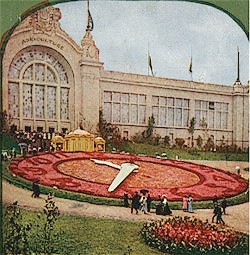Floral Clock: Difference between revisions
No edit summary |
No edit summary |
||
| Line 19: | Line 19: | ||
}} | }} | ||
The 112 foot Floral Clock was located on the northern edge of the [[Palace of Agriculture]], which operated from 8am to 8pm. | The 112 foot Floral Clock was located on the northern edge of the [[Palace of Agriculture]], which operated from 8am to 8pm. | ||
==Etymology== | ==Etymology== | ||
Revision as of 05:44, 9 November 2022
 Floral Clock |
The 112 foot Floral Clock was located on the northern edge of the Palace of Agriculture, which operated from 8am to 8pm.
Etymology
Before the Fair
Description
Not only was the timepiece the largest clock in the world, during the growing months, the clock would then have 13,000 flowering plants covering its face. At night, it was illuminated by a thousand lights.
Christian Bernard Mundt, was the Floral designer commissioned by Cornelli Seed Company, while Paul J. Ostrowski, a Polish youth from Milwaukee, was the engineer of the floral clock. The mechanism was run by compressed air, while motive power originated from the Exposition power house.
The minute hand alone weighed more than a ton (2,700 pounds), and was 75 feet long. The massive hand moved five feet per minute.
The smaller hour hand was 50 feet long.
Each number, composed of flowers was fifteen feet tall.
A large bronze gear mechanism turned the hands by a steel shaft 4 inches in diameter, which ran underground to a pavilion outside of the dial circuit. The master pneumatic clock was a smaller timepiece that controlled the gigantic floral timepiece, it was created by the Johnson Service Company of Milwaukee Wisconsin in 1903.
Within the pavilion housing the master pneumatic clock stood a 5,000 pound bell was struck on the hour and half hour. Upon each hour, a mammoth hourglass turned so the sands could run back.
